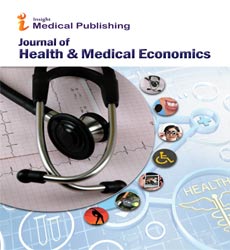Evaluating the Role of Health Insurance in Reducing Medical Inequalities
Hai Tang
Department of Economics, Liaoning University, Shenyang 110036, China
Published Date: 2025-01-28Hai Tang*
Department of Economics, Liaoning University, Shenyang 110036, China
*Corresponding author: Hai Tang, Department of Economics, Liaoning University, Shenyang 110036, China, E-mail: hai@tang.cn
Received date: January 01, 2025, Manuscript No. Ipjhme-25-20582; Editor assigned date: January 03, 2025, PreQC No. Ipjhme-25-20582 (PQ); Reviewed date: January 15, 2025, QC No. Ipjhme-25-20582; Revised date: January 22, 2025, Manuscript No. Ipjhme-25-20582 (R); Published date: January 28, 2025, DOI: 10.36648/ 2471-7975.12.1.153
Citation: Tang H (2025) Evaluating the Role of Health Insurance in Reducing Medical Inequalities. J Health Med Econ Vol.11 No.1:153
Abstract
Introduction
Health insurance is widely recognized as a crucial mechanism for improving access to healthcare and reducing medical inequalities. In many countries, disparities in healthcare arise from socioeconomic differences, with low-income populations facing barriers such as high out-of-pocket payments, limited preventive care, and delayed treatment. By pooling financial risks and ensuring coverage, health insurance plays a pivotal role in mitigating these inequities, promoting fairness, and strengthening overall health outcomes across different social groups [1].Description
From an economic perspective, health insurance reduces inequalities by lowering the burden of direct medical costs, which often push vulnerable households into poverty. By covering essential services such as primary care, hospitalization, and preventive interventions, insurance ensures that individuals receive timely medical attention without catastrophic financial consequences. In countries with universal or subsidized schemes, this effect is especially pronounced, as broader coverage leads to greater equity in access, reducing the gap between high- and low-income populations. However, in fragmented systems, unequal access to insurance itself may perpetuate disparities, highlighting the need for inclusive policies [2]. Clinically, health insurance enhances access to preventive services, medications, and regular check-ups, which are critical in addressing chronic diseases and reducing avoidable hospitalizations. Populations with insurance are more likely to receive early diagnoses and effective treatments, thereby improving survival rates and quality of life. This reduces not only health disparities but also the long-term strain on healthcare systems by shifting focus from expensive emergency care to cost-effective preventive care. Nevertheless, the extent of inequality reduction depends on the breadth of coverage. Socially, the role of health insurance extends beyond individual health to broader societal well-being. By improving equity in access, insurance schemes contribute to social stability, economic productivity, and public trust in health systems. However, challenges remain, such as gaps in coverage for informal workers, rural populations, or those in low-income countries where private insurance dominates and public schemes are underfunded. To address these, governments must design policies that ensure affordability, accessibility, and inclusivity, while also investing in healthcare infrastructure to make insurance benefits meaningful for all [3]. Health insurance remains a pivotal instrument in reducing medical inequalities, but its impact depends on the depth of coverage, equity in access, and the effectiveness of financial protection it provides. While insurance schemes can mitigate catastrophic expenditures and improve access to essential health services, disparities often persist due to gaps in benefit design, variations in provider availability, and socioeconomic barriers beyond insurance itself. Therefore, a comprehensive approach is requiredâ??one that combines universal and equitable insurance coverage with systemic reforms in healthcare delivery, targeted subsidies for vulnerable groups, and policies addressing social determinants of health. Only by integrating these dimensions can health insurance truly fulfil its promise of narrowing medical inequalities and advancing health equity on a sustainable basis [4,5].Conclusion
In summary, health insurance plays a vital role in reducing medical inequalities by improving access to healthcare, lowering financial risks, and promoting preventive care. While it has proven effective in narrowing gaps across different populations, persistent disparities remain due to unequal coverage and systemic limitations. Achieving meaningful equity requires not only expanding insurance access but also ensuring that services are comprehensive, affordable, and aligned with the needs of vulnerable communities. When implemented effectively, health insurance becomes a powerful tool for advancing both health justice and social equity.Acknowledgement
None.Conflict of Interest
None.References
- Whinnery J, Jackson N, Rattanaumpawan P, Grandner MA (2014) Short and long sleep duration associated with race/ethnicity, sociodemographics, and socioeconomic position. Sleep 37: 601-611
Google Scholar Cross Ref Indexed at
- Escourrou P, Grote L, Penzel T, McNicholas WT, Verbraecken J, et al. (2015) The diagnostic method has a strong influence on classification of obstructive sleep apnea. J Sleep Res 24: 730-738
Google Scholar Cross Ref Indexed at
- Tarasiuk A, Reuveni H (2013) The economic impact of obstructive sleep apnea. Curr Opin Pulm Med 19: 639-644
Google Scholar Cross Ref Indexed at
- Malan DP (2019) Public-private partnerships in global health. N Engl J Med 381: 193
Google Scholar Cross Ref Indexed at
- Woods CE, McPherson K, Tikoft E, Usher K, Hosseini F, et al. (2015) Sleep disorders in Aboriginal and Torres Strait Islander people and residents of regional and remote Australia. J Clin Sleep Med 11: 1263-1271
Google Scholar Cross Ref Indexed at
Open Access Journals
- Aquaculture & Veterinary Science
- Chemistry & Chemical Sciences
- Clinical Sciences
- Engineering
- General Science
- Genetics & Molecular Biology
- Health Care & Nursing
- Immunology & Microbiology
- Materials Science
- Mathematics & Physics
- Medical Sciences
- Neurology & Psychiatry
- Oncology & Cancer Science
- Pharmaceutical Sciences
